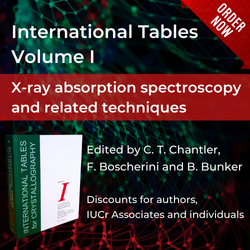
Editorial
Editorial
![thumbnail [thumbnail]](https://www.iucr.org/__data/assets/image/0017/160235/thumbnail.gif)
Figure 1. Dextrotatory structure of alpha quartz superimposed over a conoscopic image of Airy's spiral [from Geday & Glazer (2002)].
Owing to the success of the IUCr Newsletter over recent years, the Finance Committee and Executive Committee have decided that we should appear 6 times per year. So this is the first issue of the new series. You can find the usual assortment of clips from the IUCr journals, and also meeting reports, showing just how active the field of crystallography remains.
It is particularly interesting to read Istvan Hargittai's fascinating interview with the late Richard E. Marsh (https://www.iucr.org/news/newsletter/volume-33/number-1/linus-pauling,-robert-corey,-richard-marsh,-and-other-caltech-crystallographers-a-1999-conversation-with-richard-e.-marsh) since it tells us much about the personalities of some of the famous crystallographers/chemists during the 1950s at Caltech. For example, it highlights double Nobellist Linus Pauling and his associate Robert Corey, and explains how their personalities diverged and how they attempted to solve the DNA problem. Richard Marsh was well-known later for pointing out published crystal structures that were simply incorrect. The main error tended to be in determining the relevant space groups (all normal crystals have symmetries that can be classified among the 230 possible space group types; determination of the space group is usually the most crucial first step in determining a crystal structure using diffraction techniques). These days, the availability of machines that appear to solve crystal structures automatically and the lack of basic knowledge of crystallography means that false structures are sometimes accepted and published. We used to refer to the offenders as PCIs (Practicing Crystallographic Idiots). As a result of Richard Marsh's analyses, several authors found themselves being "Marshed". I am glad to say that I never received this badge of honour!
A few days ago, I was invited back to University College London, where I had been a graduate student some 60 years earlier (amazing how quickly time passes). This was to participate in a film being made for the Royal Society to celebrate 80 years since the election to the Society of the first two female scientists: Kathleen Lonsdale and Marjory Stephenson. I was there to talk about Kathleen Lonsdale as one of her few ex-students still alive. Seeing the laboratories again after such a long time felt odd. It was a trip down memory lane. Much had changed, of course, but I could still recognize some areas where I used to work. Just as in my time, there was a great deal of clutter (unbelievably, that's how we used to work). Fig. 2, below, shows, on the left, the room where my desk had been together next to that of the late Howard Flack (https://www.iucr.org/news/newsletter/volume-24/number4/howard-flack-1943-2017) and, on the right, where I recognized part of a bench in the corner of the X-ray room where I once constructed my own crystal growth apparatus.
![[Figure2]](https://www.iucr.org/__data/assets/image/0018/160236/Figure2.jpg) Figure 2. Laboratories at University College London where I studied as a graduate student.
Figure 2. Laboratories at University College London where I studied as a graduate student.
In those days, there were no screens around the X-ray tubes; we relied instead on small pieces of lead wrapped around the X-ray collimator. They leaked a lot of X-rays, so we were obviously getting a fair dose of radiation. We used photographic cameras that we pushed up and pulled away from the X-ray window. The window shutter was a simple slider that one slid to ON or OFF positions. I recall once getting a full dose of the direct beam when I hurriedly slid the shutter to the open position instead of to OFF (someone had apparently already slid the shutter to the OFF position, unbeknown to me).
![[Figure3]](https://www.iucr.org/__data/assets/image/0019/160237/Figure3.jpg) Figure 3. A Unicam rotating crystal camera pushed up against an X-ray window. This type of camera was used by Raymond Gosling at Kings College in London to obtain the first clear DNA photographs for Maurice Wilkins and Rosalind Franklin.
Figure 3. A Unicam rotating crystal camera pushed up against an X-ray window. This type of camera was used by Raymond Gosling at Kings College in London to obtain the first clear DNA photographs for Maurice Wilkins and Rosalind Franklin.
Finally, I am sorry to have to point to the latest set of obituaries: Peter Main (UK) (https://www.iucr.org/news/newsletter/volume-33/number-1/peter-main-19392024), Rajagopala Chidambaram (India) (https://www.iucr.org/news/newsletter/volume-33/number-1/rajagopala-chidambaram-19362025) and Sine Larsen (Denmark) (https://www.iucr.org/news/newsletter/volume-33/number-1/sine-ydun-larsen-19432025). I first met Sine when I joined the Finance Committee of the IUCr. We used to have our meetings in Copenhagen in her department. I remember the Danish sandwiches with pleasure and the invitation to her house deep in the countryside, where her husband cooked a wonderful dinner for us. Sine was a charming and intelligent person whom I shall personally miss.
References
Geday, M. A. & Glazer, A. M. (2002). J. Appl. Cryst. 35, 185–190.
Copyright © - All Rights Reserved - International Union of Crystallography





